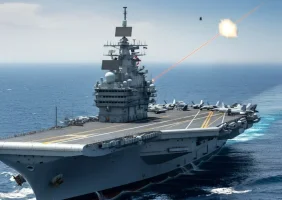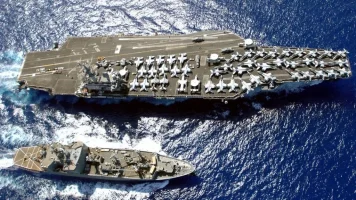- Views: 3K
- Replies: 40
The Indian Navy is facing a critical juncture in its strategic planning as it seeks to maintain maritime dominance and safeguard national security in the increasingly complex Indian Ocean Region (IOR). A key decision revolves around resource allocation between nuclear submarines and aircraft carriers.
Evidence suggests that the Indian Navy is prioritizing investment in nuclear-powered submarines (SSNs) over aircraft carriers as a more cost-effective and strategically advantageous approach to counter China's growing assertiveness in the region.
SSNs offer unmatched strategic advantages, particularly in terms of deterrence. Their ability to remain submerged for extended periods provides unparalleled stealth capabilities crucial for both defensive and offensive operations.
This makes them ideal for a second-strike capability, vital under India's "no first use" nuclear policy. Furthermore, SSNs serve as a potent deterrent beyond nuclear warfare, contributing to a credible threat perception among potential adversaries.
The Indian Ocean is witnessing increased strategic competition, particularly with China's expanding naval presence. SSNs, with their ability to patrol vast areas without surfacing, are ideally suited for surveillance, intelligence gathering, and sea denial strategies.
Experts have highlighted that India's nuclear-powered attack submarines could significantly alter the balance of power in the IOR, effectively countering China's naval expansion.
Compared to aircraft carriers, SSNs offer greater operational flexibility due to their endurance and speed. They are not reliant on external support for propulsion, allowing them to operate far from home bases without the logistical challenges that aircraft carriers face. Carriers require extensive support fleets, making them less cost-effective for stealth operations or when swift, covert movements are necessary.
Furthermore, the operational cost of maintaining an aircraft carrier significantly exceeds that of a nuclear submarine. Aircraft carriers, while powerful symbols of naval power, are also high-value targets, requiring a substantial escort fleet for protection, which escalates costs.
Submarines, on the other hand, can operate independently or with minimal support, providing a more cost-effective means of maintaining a persistent naval presence.
Advancements in missile technology and anti-ship/anti-aircraft systems have increased the vulnerability of aircraft carriers. Modern warfare is characterized by asymmetric threats, where submarines, with their inherent stealth, have a distinct advantage.
The Indian Navy's focus on SSNs aligns with this shift, emphasizing the importance of submarines capable of launching cruise missiles or torpedoes from hidden positions.
India's commitment to indigenous submarine technology under Project 75A further strengthens its position. This project aims to build six SSNs domestically, reducing reliance on foreign technology and enhancing national security through self-reliance.
The Indian Navy's planned expansion of its submarine fleet, coupled with its current emphasis on submarines over a third aircraft carrier, indicates a strategic shift towards a more sustainable and effective force structure.
This approach not only addresses immediate threats but also prepares for future naval engagements where sea control and denial will be critical.
By prioritizing SSNs, the Indian Navy is making a strategic investment in a cost-effective, versatile, and potent platform that is ideally suited to counter the evolving challenges in the Indian Ocean Region.
This approach allows India to effectively respond to China's growing assertiveness while maintaining a credible deterrent and ensuring its maritime dominance in the future.


